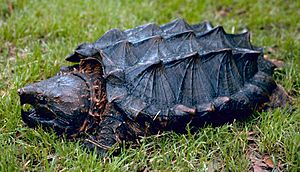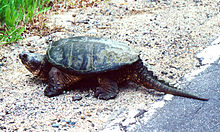Alligator turtles
| Alligator turtles | ||||||||||||
|---|---|---|---|---|---|---|---|---|---|---|---|---|

Vulture turtle ( Macrochelys temminckii ) |
||||||||||||
| Systematics | ||||||||||||
|
||||||||||||
| Scientific name | ||||||||||||
| Chelydridae | ||||||||||||
| Gray , 1831 |
The alligator turtles (Chelydridae) are a family of turtles with five or six recent species in two genera in North America , Central America, and northern South America . These are the snapping turtles ( Chelydra ) and the vulture turtles ( Macrochelys ). In addition, several species have been handed down in fossil form .
features
The alligator turtles living today are very large and compactly built turtles with a strong back shell ( carapace ). The snapping turtle reaches a size of about 45 centimeters with an average weight of 15 to a maximum of about 30 kilograms, while the vulture turtle with a maximum shell length of almost 70 centimeters can weigh up to 100 kilograms and is therefore one of the largest freshwater turtles in the world. Both species have strong jaws and, like all Halsberger turtles , can pull their head, legs and tail under the shell.
distribution
The snapping turtles come from Canada via the USA and Central America to the north of South America to Ecuador and live in slowly flowing waters with a boggy bottom. The vulture turtles live exclusively in the area of the Mississippi River and its larger tributaries.
Way of life
All species of alligator turtles live in the fresh water of larger, slow-moving streams with a muddy bottom. They hunt for fish and other animals by burrowing in the mud and sticking out their red-colored tongues to catch fish that have been attracted. Otherwise they dig in the mud and look for benthic organisms as well as carcasses and aquatic plants.
To lay their eggs, the animals go ashore and bury their 10 to 40 eggs in the loose soil, where the young animals hatch after around 70 to 80 days.
Tribal history and systematics
Representatives of the alligator turtles are found to be found in fossils up to the late Cretaceous period and have inhabited large parts of the northern hemisphere (Asia, Europe and North America). The oldest fossil comes from Emarginachelys cretacea from the Maastrichtian about 70 million years ago in today's Montana . The very well-preserved fossil of Protochelydra zangerli with very high domes on the back armor as an adaptation to protect against turtle-hunting crocodiles of this time comes from the late Paleocene of today's North Dakota . From the genus Chelydropsis several fossil species from the Oligocene to the Pliocene have been identified in Europe.
Systematics
There are currently five or six species of alligator turtles belonging to two genera:
-
Snapping turtles ( Chelydra )
- South American snapping turtle ( Chelydra acutirostris Peters , 1862 )
- Central American snapping turtle ( Chelydra rossignonii ( Bocourt , 1868) )
- Snapping turtle ( Chelydra serpentina ( Linnaeus , 1758) )
-
Vulture turtles ( Macrochelys )
- Apalachicola vulture turtle ( Macrochelys apalachicolae Thomas, Granatosky, Bourque, Krysko, Moler, Gamble, Suarez, Leone & Roman , 2014 ; species status controversial as there are no diagnostic differences to Macrochelys temminckii )
- Suwannee vulture turtle ( Macrochelys suwanniensis Thomas, Granatosky, Bourque, Krysko, Moler, Gamble, Suarez, Leone & Roman , 2014 )
- Vulture tortoise ( Macrochelys temminckii Troost , 1835 )
Economical meaning
Both the snapping turtles and the vulture turtles are hunted in their homeland. The meat of the animals is considered a local delicacy and is accordingly gladly prepared and eaten.
literature
- Günther Peters: Family Chelydridae - alligator turtles in: Urania animal kingdom. Fish, amphibians, reptiles. Urania-Verlag, Berlin 2000; Pages 504-505. ISBN 3-332-01167-7 .
Individual evidence
- ↑ a b Travis M. Thomas, Michael C. Granatosky, Jason R. Bourque, Kenneth L. Krysko, Paul E. Moler, Tony Gamble, Eric Suarez, Erin Leone, Kevin M. Enge & Joe Roman: Taxonomic assessment of Alligator Snapping Turtles (Chelydridae: Macrochelys ), with the description of two new species from the southeastern United States. Zootaxa 3786 (2): pp. 141 - 165, doi : 10.11646 / zootaxa.3786.2.4 .
- ↑ Brian Torture & Craig Guyer: Evaluating recent taxonomic changes for alligator snapping turtles (Testudines: Chelydridae). Zootaxa 3947 (3): 447-450 (Apr. 2015), doi: 10.11646 / zootaxa.3947.3.11
